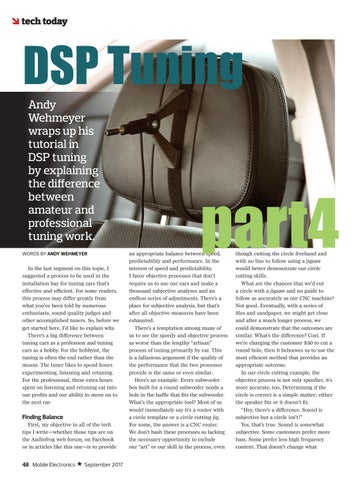tech today
DSP Tuning Andy Wehmeyer wraps up his tutorial in DSP tuning by explaining the difference between amateur and professional tuning work.
WORDS BY ANDY WEHMEYER
In the last segment on this topic, I suggested a process to be used in the installation bay for tuning cars that’s effective and efficient. For some readers, this process may differ greatly from what you’ve been told by numerous enthusiasts, sound quality judges and other accomplished tuners. So, before we get started here, I’d like to explain why. There’s a big difference between tuning cars as a profession and tuning cars as a hobby. For the hobbyist, the tuning is often the end rather than the means. The tuner likes to spend hours experimenting, listening and retuning. For the professional, these extra hours spent on listening and retuning eat into our profits and our ability to move on to the next car.
Finding Balance First, my objective in all of the tech tips I write—whether those tips are on the Audiofrog web forum, on Facebook or in articles like this one—is to provide
48 Mobile Electronics September 2017
an appropriate balance between speed, predictability and performance. In the interest of speed and predictability, I favor objective processes that don’t require us to use our ears and make a thousand subjective analyses and an endless series of adjustments. There’s a place for subjective analysis, but that’s after all objective measures have been exhausted. There’s a temptation among many of us to see the speedy and objective process as worse than the lengthy “artisan” process of tuning primarily by ear. This is a fallacious argument if the quality of the performance that the two processes provide is the same or even similar. Here’s an example: Every subwoofer box built for a round subwoofer needs a hole in the baffle that fits the subwoofer. What’s the appropriate tool? Most of us would immediately say it’s a router with a circle template or a circle cutting jig. For some, the answer is a CNC router. We don’t bash these processes as lacking the necessary opportunity to include our “art” or our skill in the process, even
though cutting the circle freehand and with no line to follow using a jigsaw would better demonstrate our circle cutting skills. What are the chances that we’d cut a circle with a jigsaw and no guide to follow as accurately as our CNC machine? Not good. Eventually, with a series of files and sandpaper, we might get close and after a much longer process, we could demonstrate that the outcomes are similar. What’s the difference? Cost. If we’re charging the customer $30 to cut a round hole, then it behooves us to use the most efficient method that provides an appropriate outcome. In our circle cutting example, the objective process is not only speedier, it’s more accurate, too. Determining if the circle is correct is a simple matter; either the speaker fits or it doesn’t fit. “Hey, there’s a difference. Sound is subjective but a circle isn’t!” Yes, that’s true. Sound is somewhat subjective. Some customers prefer more bass. Some prefer less high frequency content. That doesn’t change what
